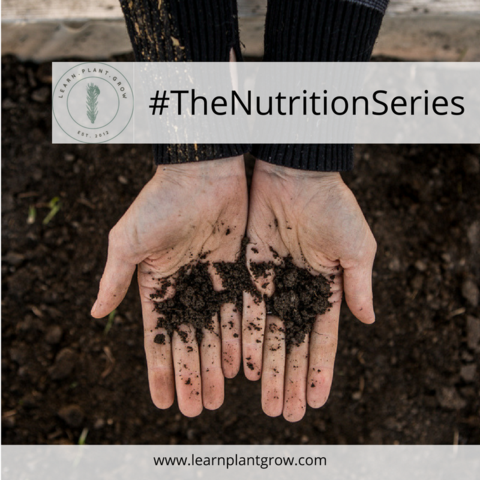#TheNutritionSeries Part 2

This post was co-authored by my awesome husband Tanner Pollack. Tanner’s background is agronomy (the science of growing crops) with a focus on crop production. He runs an agronomy consulting business and farms in Northern Alberta.
Why you need chemicals to grow your plants (and shouldn’t be afraid of them)
The vegetables and flowers you grow in your garden are truly amazing. They take sunlight, air, and water, along with chemicals and minerals from the soil, and create usable and beautiful plants (or both!) that enrich our lives. Over the next 3 blog posts in #TheNutritionSeries we’ll start to dig deeper into how plants make this magic happen.
If you google plant nutrition, you’ll see that the nutrients are broken down into 4 groups (check out Plant nutrition). These groups are assigned by what percentage of the plant they make up. The nutrient groups are:
- Macronutrients (from air and water)
- Primary Macronutrients
- Secondary & Tertiary Macronutrients
- Micronutrients
And with that, let’s dive in!
Let’s roll back and review a little chemistry. Remember the Periodic Table of Elements we all had to memorize in science? Air and water give us the elements Carbon, Hydrogen, and Oxygen.
So… Carbon, Hydrogen, and Oxygen make up our first group, Macronutrients. Together, our beautiful air (which provides carbon dioxide and oxygen) and water (which provides the little molecule made up of two hydrogens and one oxygen) gives our plants the raw elements needed for the amazing process of photosynthesis! (Are you as excited as we are about this?)
Photosynthesis is the process by which plants use light energy to capture carbon and convert it into chemical energy; in this case, glucose (a simple sugar). The plant requires two main inputs – carbon dioxide and water. In its simplest chemical terms, photosynthesis is
6 CO2 + 6 H2O + Light –-> C6H12O6 + 6 O2
How cool is that? In the presence of light, plants take carbon dioxide and water, break the chemical bonds, and re-form them into glucose and oxygen! Ahhhhh!!! I wish I had magic like that!
Now, let’s dig a little deeper into each of these nutrients.
Carbon
Carbon really is the element of life. Once the plant has converted carbon dioxide into glucose, it can start to use it to make all sorts of different chemical compounds. The plant, through various biochemical processes, uses the carbon molecules in glucose to build literally everything! Glucose molecules are bonded together to form starch (for energy) or cellulose (fiber – a plant structure component) in the plant. Glucose can have one carbon removed and become fructose; when a glucose and a fructose are bonded together, they make sucrose (sugar)! Plants also take the glucose molecule and use it as the starting point for amino acids (by splitting glucose and adding different amine groups) to build proteins, and as the starting point for lipid (oils and fats) formation in the plant. Without carbon (carbon dioxide), none of this would be possible.
Oxygen
Oxygen is a byproduct of photosynthesis – the plant releases it into the atmosphere for us to breathe! But did you know that plants also use oxygen? That’s right! When the lights go out, plants are no longer photosynthesizing; they begin to respire. What is respiration? It’s how plants take all this stored energy (glucose) and start to use that energy to grow. Think of it as fire – you need oxygen for things to burn. Our plants are always using oxygen molecules in their biochemical processes, splitting oxygen off of carbon dioxide and other oxygen-containing molecules (nitrate, phosphate, sulphate, etc.), or using them to create bonds between smaller molecules to create new, larger molecules.
Hydrogen
#1 in the periodic table, little hydrogen is a big player in plants. Hydrogen gets used in all sorts of ways: it’s attached to molecules to balance out charges; the addition (or subtraction) of hydrogen is used to transport electrons around the plant; movement of hydrogen across a cell membrane (called a proton gradient) provides power for moving other molecules into and out of cells. A plant’s main source of hydrogen is actually water! Biochemical processes in the plant are able to split one of the hydrogens off the water molecule for the plant to use.
The great thing about these three important nutrients is that they are free! In the air we breathe, and the rain that falls, plants can generally get all the carbon, oxygen, and hydrogen they need. In specialized cases, we need to add water (think irrigation outside, and our indoor greenhouse systems). Large greenhouses, especially vegetable growers, may have to add carbon dioxide as well. The rapidly growing plants deplete the carbon dioxide in the air to levels that are too low for optimal production of vegetables – the plants become carbon starved.
Next week, we’ll dive into the primary macronutrients – nitrogen, phosphorous, and potassium.
Sources:
Marschner, Horst. Mineral Nutrition of Higher Plants, second edition. Academic Press, 1995.
Comments +